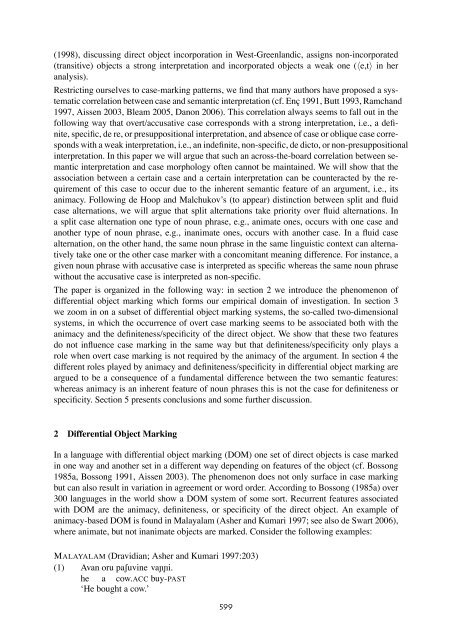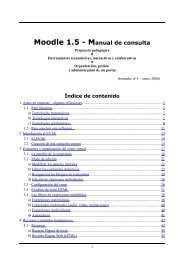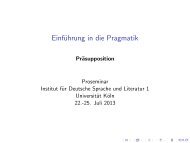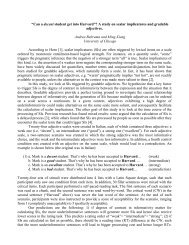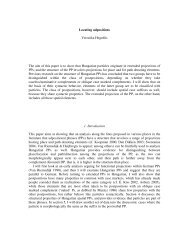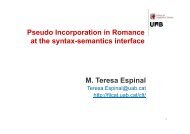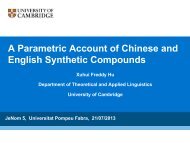Semantic aspects of differential object marking - corpora@parles.upf ...
Semantic aspects of differential object marking - corpora@parles.upf ...
Semantic aspects of differential object marking - corpora@parles.upf ...
You also want an ePaper? Increase the reach of your titles
YUMPU automatically turns print PDFs into web optimized ePapers that Google loves.
2 Peter de Swart and Helen de Hoop<br />
(1998), discussing direct <strong>object</strong> incorporation in West-Greenlandic, assigns non-incorporated<br />
(transitive) <strong>object</strong>s a strong interpretation and incorporated <strong>object</strong>s a weak one (〈e,t〉 in her<br />
analysis).<br />
Restricting ourselves to case-<strong>marking</strong> patterns, we find that many authors have proposed a systematic<br />
correlation between case and semantic interpretation (cf. Enç 1991, Butt 1993, Ramchand<br />
1997, Aissen 2003, Bleam 2005, Danon 2006). This correlation always seems to fall out in the<br />
following way that overt/accusative case corresponds with a strong interpretation, i.e., a definite,<br />
specific, de re, or presuppositional interpretation, and absence <strong>of</strong> case or oblique case corresponds<br />
with a weak interpretation, i.e., an indefinite, non-specific, de dicto, or non-presuppositional<br />
interpretation. In this paper we will argue that such an across-the-board correlation between semantic<br />
interpretation and case morphology <strong>of</strong>ten cannot be maintained. We will show that the<br />
association between a certain case and a certain interpretation can be counteracted by the requirement<br />
<strong>of</strong> this case to occur due to the inherent semantic feature <strong>of</strong> an argument, i.e., its<br />
animacy. Following de Hoop and Malchukov’s (to appear) distinction between split and fluid<br />
case alternations, we will argue that split alternations take priority over fluid alternations. In<br />
a split case alternation one type <strong>of</strong> noun phrase, e.g., animate ones, occurs with one case and<br />
another type <strong>of</strong> noun phrase, e.g., inanimate ones, occurs with another case. In a fluid case<br />
alternation, on the other hand, the same noun phrase in the same linguistic context can alternatively<br />
take one or the other case marker with a concomitant meaning difference. For instance, a<br />
given noun phrase with accusative case is interpreted as specific whereas the same noun phrase<br />
without the accusative case is interpreted as non-specific.<br />
The paper is organized in the following way: in section 2 we introduce the phenomenon <strong>of</strong><br />
<strong>differential</strong> <strong>object</strong> <strong>marking</strong> which forms our empirical domain <strong>of</strong> investigation. In section 3<br />
we zoom in on a subset <strong>of</strong> <strong>differential</strong> <strong>object</strong> <strong>marking</strong> systems, the so-called two-dimensional<br />
systems, in which the occurrence <strong>of</strong> overt case <strong>marking</strong> seems to be associated both with the<br />
animacy and the definiteness/specificity <strong>of</strong> the direct <strong>object</strong>. We show that these two features<br />
do not influence case <strong>marking</strong> in the same way but that definiteness/specificity only plays a<br />
role when overt case <strong>marking</strong> is not required by the animacy <strong>of</strong> the argument. In section 4 the<br />
different roles played by animacy and definiteness/specificity in <strong>differential</strong> <strong>object</strong> <strong>marking</strong> are<br />
argued to be a consequence <strong>of</strong> a fundamental difference between the two semantic features:<br />
whereas animacy is an inherent feature <strong>of</strong> noun phrases this is not the case for definiteness or<br />
specificity. Section 5 presents conclusions and some further discussion.<br />
2 Differential Object Marking<br />
In a language with <strong>differential</strong> <strong>object</strong> <strong>marking</strong> (DOM) one set <strong>of</strong> direct <strong>object</strong>s is case marked<br />
in one way and another set in a different way depending on features <strong>of</strong> the <strong>object</strong> (cf. Bossong<br />
1985a, Bossong 1991, Aissen 2003). The phenomenon does not only surface in case <strong>marking</strong><br />
but can also result in variation in agreement or word order. According to Bossong (1985a) over<br />
300 languages in the world show a DOM system <strong>of</strong> some sort. Recurrent features associated<br />
with DOM are the animacy, definiteness, or specificity <strong>of</strong> the direct <strong>object</strong>. An example <strong>of</strong><br />
animacy-based DOM is found in Malayalam (Asher and Kumari 1997; see also de Swart 2006),<br />
where animate, but not inanimate <strong>object</strong>s are marked. Consider the following examples:<br />
MALAYALAM (Dravidian; Asher and Kumari 1997:203)<br />
(1) Avan oru paSuvine vaññi.<br />
he a cow.ACC buy-PAST<br />
‘He bought a cow.’<br />
599<br />
2


